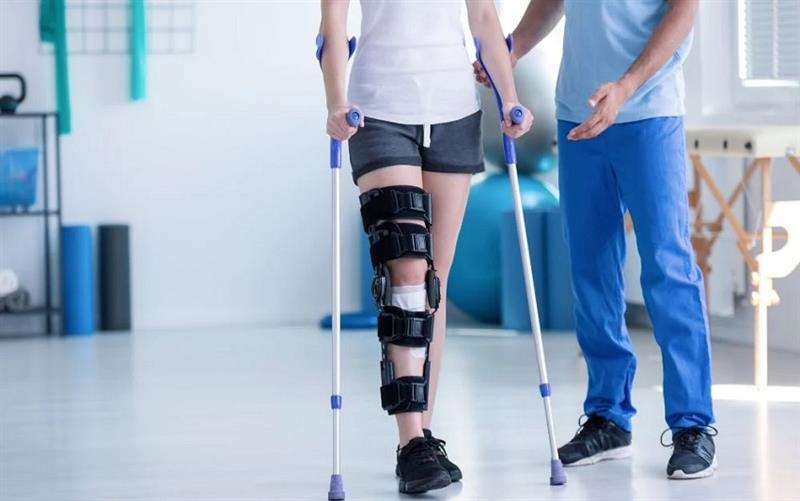
The Evolution of Crutches
Crutches have come a long way in terms of design, materials, and functionality. What started as simple wooden sticks has transformed into a range of specialized devices to cater to different needs and preferences. Let's delve into the world of crutches and discover the options available today.
1. Standard Underarm Crutches
Standard underarm crutches, also known as axillary crutches, are the most common and recognizable type. They consist of a padded underarm support and handgrips. These crutches are typically made of lightweight materials like aluminum. They are often used for temporary mobility assistance, such as during recovery from a leg injury or surgery.
Pros:
- Easy to use for beginners.
- Provide support and stability.
Cons:
- Can be uncomfortable for prolonged use.
- Underarms may experience discomfort or bruising.
2. Forearm Crutches
Forearm crutches, sometimes called elbow crutches, offer a more comfortable and ergonomic design. They feature a cuff that goes around the forearm, providing additional support. This type of crutch is ideal for individuals with long-term mobility issues or those who require more stability.
Pros:
- Reduce pressure on the underarms.
- Provide better support for individuals with chronic conditions.
Cons:
- May require some practice to use properly.
- Cuff fit is crucial for comfort and effectiveness.
3. Platform Crutches
Platform crutches have a unique design with an open cuff and a platform for the forearm. They offer excellent support and are ideal for people who need additional upper body strength. The open cuff design makes them easier to put on and take off compared to standard underarm crutches.
Pros:
- Distribute weight evenly on the forearm.
- Comfortable and stable.
Cons:
- May be bulkier and less portable.
- Not suitable for individuals with limited arm mobility.
4. Hands-Free Crutches
Hands-free crutches, like the iWALK2.0, represent a revolutionary advancement in crutch technology. They allow individuals to regain the use of their hands while providing support through an innovative design that straps to the thigh. These crutches are especially beneficial for those who need full use of their hands during recovery.
Pros:
- Enable hands-free mobility.
- Provide a more natural walking experience.
Cons:
- Require some practice to use effectively.
- Not suitable for all types of injuries.
5. Knee Scooters
Knee scooters are an alternative to traditional crutches. They offer a more comfortable and effortless way to move around, especially for individuals recovering from foot or ankle injuries. Knee scooters have a platform for the injured leg, allowing the user to push themselves with the non-injured leg.
Pros:
- Highly maneuverable.
- Suitable for long-term use.
- Reduce strain on the upper body.
Cons:
- Limited functionality on uneven terrain.
- May not be suitable for individuals with certain injuries.
6. All-Terrain Crutches
All-terrain crutches are designed for those who lead an active lifestyle and want to maintain their mobility even on rough or uneven surfaces. They often feature shock absorbers, sturdy grips, and off-road tips, making them perfect for outdoor adventures like hiking and trail walking.
Pros:
- Provide stability on various terrains.
- Durable and rugged design.
Cons:
- Can be bulkier than standard crutches.
- May be more expensive.
7. Pediatric Crutches
Pediatric crutches are specifically designed for children. These crutches ensure that young users have the right support and comfort during their recovery process. They are often adjustable to accommodate a child's growth.
Pros:
- Sized for children.
- Lightweight and colorful designs for appeal.
Cons:
- Outgrown as the child grows.
- May require frequent adjustments.
8. Bariatric Crutches
For individuals with heavier weight requirements, bariatric crutches offer the needed strength and durability. These crutches are designed to withstand higher loads and provide support for individuals with obesity.
Pros:
- Designed for heavy-duty use.
- Provide enhanced stability.
Cons:
- Can be heavier and less portable.
- May not be suitable for individuals with average body weight.
9. Spring-Assisted Crutches
Spring-assisted crutches have a built-in spring mechanism in the shaft, which helps reduce the impact on the arms and shoulders during each step. They are often chosen by individuals who have arthritis or require crutches for an extended period.
Pros:
- Reduce the impact on the upper body.
- Enhanced shock absorption for comfort.
Cons:
- Slightly heavier than standard crutches.
- The spring mechanism requires maintenance.
10. Body-Powered Crutches
Body-powered crutches are designed for individuals with limited hand strength or dexterity. These crutches utilize a system of straps and body movements to assist in walking.
Pros:
- Suitable for those with hand mobility issues.
- Provide greater independence in mobility.
Cons:
- May have a steeper learning curve.
- Straps and adjustments may require occasional maintenance.
11. Hemi Walker Crutches
Hemi walker crutches are a combination of a walker and a crutch. They have a larger base with four legs for added stability and are often used by individuals with partial weight-bearing restrictions or those recovering from a stroke.
Pros:
- Offer superior stability.
- Ideal for those with balance issues.
Cons:
- Less portable than other crutches.
- Limited use on stairs.
12. Gutter Crutches
Gutter crutches are an alternative to standard underarm crutches, often used in the United Kingdom. They feature a trough-shaped cuff that supports the forearm and can be beneficial for those with specific mobility needs.
Pros:
- Allow comfortable resting of the forearm.
- Can be a suitable option for specific medical conditions.
Cons:
- Less common and may be harder to find.
- Cuff design may require adjustment for comfort.